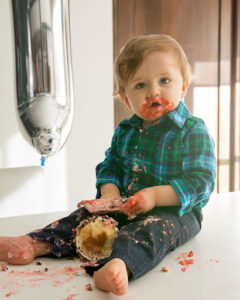 Do you fear letting your baby get messy? Can’t stand the sight of food in their hair or on the floor and dread the work that it means for you afterwards? You are not alone! Lots of parents have a really hard time allowing their baby to be a complete and total mess while eating. But did you know that this mess is more than just a headache for you later on? It is actually a critical learning experience for your little one! So next time you cringe at the sight of your toddler flinging applesauce across the room or your baby dropping yet another yogurt-covered spoon on the floor, remember that you are helping their development.
Do you fear letting your baby get messy? Can’t stand the sight of food in their hair or on the floor and dread the work that it means for you afterwards? You are not alone! Lots of parents have a really hard time allowing their baby to be a complete and total mess while eating. But did you know that this mess is more than just a headache for you later on? It is actually a critical learning experience for your little one! So next time you cringe at the sight of your toddler flinging applesauce across the room or your baby dropping yet another yogurt-covered spoon on the floor, remember that you are helping their development.
Below is a list of reasons why you should let your little one get messy while eating.
Messy eating…
- Provides important sensory experiences
- Messy eating is a form of sensory play! It is an opportunity for your little one’s brain to receive feedback from their food regarding different textures, temperatures, colors, quantities and the difference between solid and non-solid foods. This sensory play promotes exploration and helps build a positive environment around their food.
- Leads to greater acceptance of foods
- Once children are familiar and comfortable with the sensory information of their food, they are more willing to eat it. Sensory play and exploration helps kids overcome their fear of new textures and flavors and results in eating a more diverse diet.
- Promotes appropriate self-feeding skills
- Allowing your little one to explore their food builds confidence and promotes independent eating.
- Develops fine motor skills
- Self-feeding involves pinching, picking-up, reaching, holding a spoon and a number of find motor skills that your kiddo may be missing out on if you are always the one in control of the food container and spoon.
Tips to help the messy eating routine:
- Prepare for a mess by feeding your baby or toddler in a room with hard, easy to clean surfaces (i.e. tile, wood) and avoiding carpeted areas. Use placemats, floormats or even lay a towel or sheet down under the highchair.
- Ditch the nice clothes and opt for an old t-shit or onesie instead. You can even let your little one eat in only their diaper to avoid excess laundry! As long as it is a comfortable temperature in your house, your baby will not be too cold and it will save you a lot of time and hassle.
- Embrace the messy eating. Remind yourself that this GOOD and fun! Enjoy these moments and capture one of those classic-baby-moment pictures.
Kelly Fridholm, MCD, CCC-SLP
Speech-Language Pathologist
Additional resources/related articles:
https://www.reuters.com/article/us-food-fears-children/playing-with-food-may-help-preschoolers-become-less-picky-eaters-idUSKBN0O41MD20150519
Picture: Shutterstock


 Do you fear letting your baby get messy? Can’t stand the sight of food in their hair or on the floor and dread the work that it means for you afterwards? You are not alone! Lots of parents have a really hard time allowing their baby to be a complete and total mess while eating. But did you know that this mess is more than just a headache for you later on? It is actually a critical learning experience for your little one! So next time you cringe at the sight of your toddler flinging applesauce across the room or your baby dropping yet another yogurt-covered spoon on the floor, remember that you are helping their development.
Do you fear letting your baby get messy? Can’t stand the sight of food in their hair or on the floor and dread the work that it means for you afterwards? You are not alone! Lots of parents have a really hard time allowing their baby to be a complete and total mess while eating. But did you know that this mess is more than just a headache for you later on? It is actually a critical learning experience for your little one! So next time you cringe at the sight of your toddler flinging applesauce across the room or your baby dropping yet another yogurt-covered spoon on the floor, remember that you are helping their development.